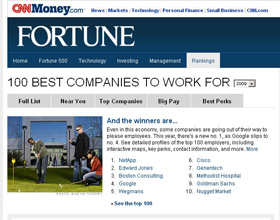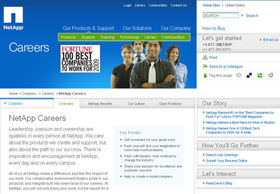The new Fortune list of 100 Best Companies to Work For is out—and as always, it offers great information and ideas. So this will be the first of three posts that explore the list, to find out more about what we might call the ’employer brand.’ Basic idea:
Job-seekers will judge your company at least as much by its ’employer brand’ as by its ‘customer brand.’ The Careers site harmonizes with the customer brand—but it communicates the employer brand.
Today’s post will look for useful lessons from the top three companies on the Fortune list. Part 2 of the series will take up the cautionary tale of two-time winner Google, considering whether (and how) to leverage perks on the Careers website. Finally, Part 3 will do some speed-dating with 50 or so of these employee-friendly companies, in search of common threads and good ideas.
Now, to end the suspense . . . at win, place and show: NetApp, Edward Jones, and Boston Consulting. When I visited their Career sites, I found that NetApp and Edward Jones are already leveraging their Fortune ranking, with badges and links that grab your attention on the Careers home page and also on the corporate home page. (The Fortune print issue is not out yet, but the list is up on their website.) That signals attention to the site, as well as an appreciation for the importance of employer branding.
I also found that all three of these sites are attractive, interesting, and easy to navigate. But most important — all three have a pronounced focus on individual employees. And instead of talking about the company, or talking about people in general, all three sites employ a consistent, apparent ‘you’ focus.
I’ll pound this home by bolding some relevant bits from their sites, as follows:
- NetApp starts big with the first sentence: ‘Leadership, passion and ownership are qualities in every person at NetApp.’ Prominent on their Careers page is a list of key points (“Get rewarded for your great work,” “Push yourself and your imagination,” etc.) that immediately puts the visitor inside the message.
Edward Jones also starts off with a personalized headline (‘Welcome to Your Career at Edward Jones’) and follows up in the first sentence with ‘we’re known for our personal approach to business.’
- BCG has a similar all-about-you focus, with messaging topics like ‘Chart Your Own Course’, ‘Challenge Your Mind,’ and ‘Is BCG for Me?’
Obviously these three companies are very different. They range in size from relatively tiny BCG (1,680 employees) to mid-sized NetApp (5,014) to the fairly large Edward Jones (34,496), and they have different business model and employee populations. But their common emphasis on individual employees seems to endear them to workers—and that emphasis is evident in their Careers messaging.
For a reality check on this point, I went way down the Fortune list to number 72, Nordstrom, and compared their Careers messaging to Macy’s, which is not on the list. (Picked these two because they are apples-to-apples.) Sure enough . . . the Nordstrom page starts off with the headline “Your Bright Future.”
The Macy’s headline? “Opportunities for Success.”
Not exactly a scientific survey, I know—but pretty interesting. Nordstrom’s message goes on with a paragraph containing 44 words, 10% of which are some version of ‘you.’ Over at Macy’s the very first word on the page is ‘We.’ In fairness, there are some ‘you’ sections on the Macy’s site, but they are buried at lower levels, so the impression you get from a quick visit is not especially personal. (And it’s worth noting that the word ‘we’ does not ever appear on the Nordstrom top page—it’s all about ‘you.’)
Now, it may very well be that Macy’s is just as person-friendly as Nordstrom, or more so! But you wouldn’t know it from the messaging. So our takeaway for Part 1 is . . . figure out whether the Careers message is effectively communicating your company’s commitment to individual employees.
And PS: The online Fortune list provides plenty of details about all 100 companies, with enough slicing-and-dicing to make the information worth exploring!
Cynthia Giles has followed a serpentine career path from academia to publishing to marketing and design to information technology and corporate communications. There’s plenty of detail about this journey at www.cynthiagiles.com, but briefly--the common theme has been ideas, and how to present them effectively. Along the way, she became an accidental expert on data warehousing and business intelligence, and for the past ten years she has combined corporate contracting with an independent consulting practice that focuses on marketing strategy for smaller businesses and non-profits.
Having spent quite a bit of time looking for work, and anywhere from two weeks to two years inside a wide variety of American companies—she has given much thought to what works (and what doesn’t) when it comes to creating a great employment fit.




